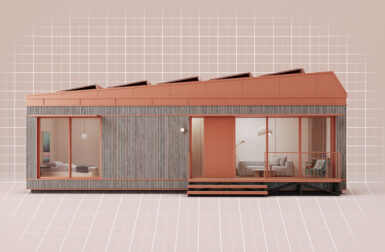Concrete is part of the language of modern architecture, especially lately. Foscarini uses the material in a new way in creating its Aplomb pendant. The name Aplomb is inspired by the plumb-bob tool traditionally used by masons. Aplomb also means “self-possessed” and “confident.” The piece was designed by Paolo Lucidi and Luca Pevere of Studio Lucidi & Pevere, based in Udine, Italy. This month’s Deconstruction takes a look at how it’s done.

Every masterpiece starts up with a sketch. Here’s the first one of Aplomb by its designers Paolo Lucidi and Luca Pevere. The partnership between the two designers, Foscarini, and the artisans who produced the piece has been extremely precious and has allowed to us achieve an extraordinary interesting result.

Once it has been decided on the kind of light to create, the industrial process takes over. Fom a sketch paper sheet to the factory, that’s how it goes. Developing an intuition can be a surprising, amazing experience. This image shows the place outside the factory with the cement powder.

Here we see the mixture used to create the lamp. Aplomb is made of a special concrete amalgam, which is particularly fluid in the mold and produces a surface that appears rough, but which is gentle to the touch, as refined by a transparent layer finish.

Combining the need to obtain highly reduced dimensions and thickness, detailed finishes and smooth surfaces with the characteristic viscosity and lack of flexibility of concrete was the greatest challenge in developing Aplomb. As you see here, the material is poured into the mould and then it is opened; the piece is removed and then eventually finished. The final result is achieved thanks to the use of a special amalgam developed for this project.

After several studies to identify the right proportions of the materials, we had to identify the best colors to match with the shape. Those colors have been obtained by introducing pigments directly into the mixture. These are the pigments used to create the various colors—grey, white, brown. There are oxides mixed in various proportions, which is what creates the final color.

In this picture we see the first color tests, with the three different color varieties that we have identified.

An aspect that we cared a lot about in the development process was finding the right balance between an industrial and a handcrafted object. When we look at the surface we see that the lamp has an airy design, with the characteristic shape of an upside-down funnel. This mitigates the massive solidity of concrete, yet celebrates its material aspect. Its surface appears rough, but it is gentle to the touch, since it is refined by a transparent layer finish. In order to obtain this final effect, the ruggedness and the porosity of the surface had to be studied for a long time.

Aplomb comes in three color finishes that highlight its personality and meet different styles. There’s the classic gray of rough concrete, which gives depth to volumes; an elegant white; a warm, intense brown. Gray recalls the world of architecture where bare concrete is a dominating aesthetic feature. We liked white for more refined environments. We chose brown as the third color because it is perfectly suitable with warmer environments, like bistros.






